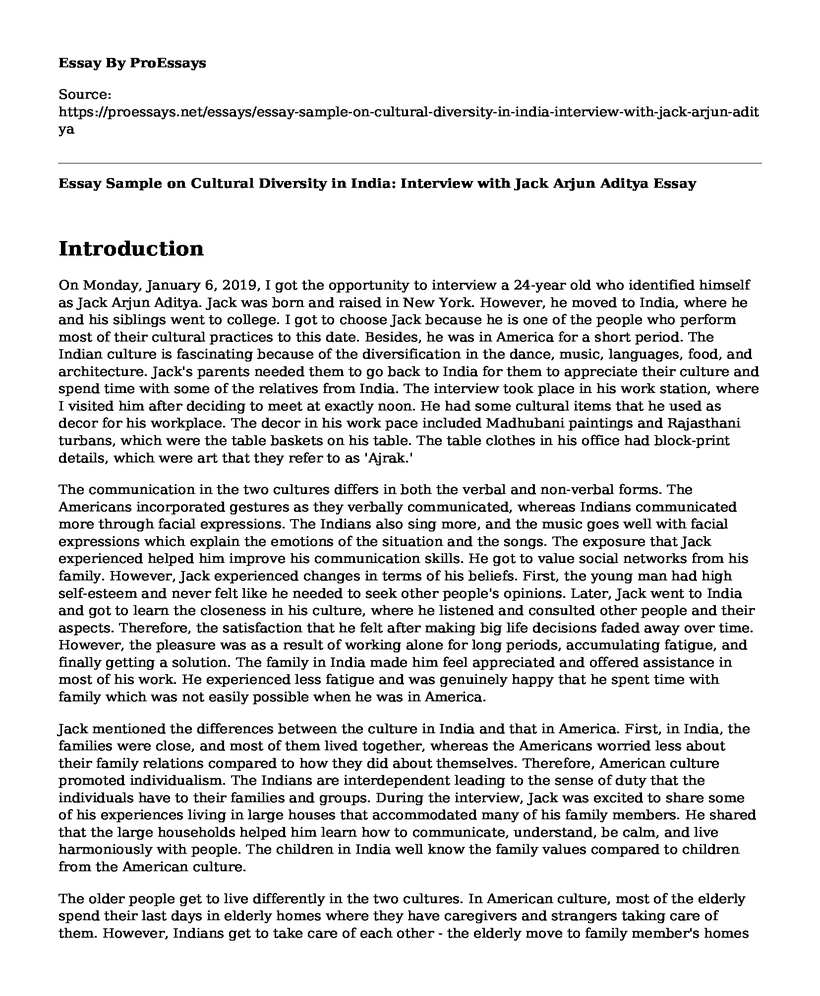Introduction
On Monday, January 6, 2019, I got the opportunity to interview a 24-year old who identified himself as Jack Arjun Aditya. Jack was born and raised in New York. However, he moved to India, where he and his siblings went to college. I got to choose Jack because he is one of the people who perform most of their cultural practices to this date. Besides, he was in America for a short period. The Indian culture is fascinating because of the diversification in the dance, music, languages, food, and architecture. Jack's parents needed them to go back to India for them to appreciate their culture and spend time with some of the relatives from India. The interview took place in his work station, where I visited him after deciding to meet at exactly noon. He had some cultural items that he used as decor for his workplace. The decor in his work pace included Madhubani paintings and Rajasthani turbans, which were the table baskets on his table. The table clothes in his office had block-print details, which were art that they refer to as 'Ajrak.'
The communication in the two cultures differs in both the verbal and non-verbal forms. The Americans incorporated gestures as they verbally communicated, whereas Indians communicated more through facial expressions. The Indians also sing more, and the music goes well with facial expressions which explain the emotions of the situation and the songs. The exposure that Jack experienced helped him improve his communication skills. He got to value social networks from his family. However, Jack experienced changes in terms of his beliefs. First, the young man had high self-esteem and never felt like he needed to seek other people's opinions. Later, Jack went to India and got to learn the closeness in his culture, where he listened and consulted other people and their aspects. Therefore, the satisfaction that he felt after making big life decisions faded away over time. However, the pleasure was as a result of working alone for long periods, accumulating fatigue, and finally getting a solution. The family in India made him feel appreciated and offered assistance in most of his work. He experienced less fatigue and was genuinely happy that he spent time with family which was not easily possible when he was in America.
Jack mentioned the differences between the culture in India and that in America. First, in India, the families were close, and most of them lived together, whereas the Americans worried less about their family relations compared to how they did about themselves. Therefore, American culture promoted individualism. The Indians are interdependent leading to the sense of duty that the individuals have to their families and groups. During the interview, Jack was excited to share some of his experiences living in large houses that accommodated many of his family members. He shared that the large households helped him learn how to communicate, understand, be calm, and live harmoniously with people. The children in India well know the family values compared to children from the American culture.
The older people get to live differently in the two cultures. In American culture, most of the elderly spend their last days in elderly homes where they have caregivers and strangers taking care of them. However, Indians get to take care of each other - the elderly move to family member's homes that are more accommodating in terms of caregiving and attention. The percentage of divorce in India was lower than in America. Jack mentioned how he was surprised by the quick response of the Americans to the problems they encountered. In his college, the administration ensured that the challenges faced by the staff and the students were dealt with immediately. The Indians lived in harmony and avoided situations that would make them contradict nature. Besides, the Americans were quick to respond to changes in the environment because they are goal-oriented. Most of the Indians gave up opportunities, dreams, and happiness because of family ties and relations. The Indians lived lives that were stress-free from mobility. The Indians work hard to meet the needs of large households, making them more competitive compared to Americans.
Conclusion
In conclusion, American and Indian cultures have many differences; however, there are a few similarities. In Jack's opinion, American culture made people get lost in their careers, powers, and isolation. However, it helped him grow as an individual and get to understand his ambitions. The support in India excites him because he is hopeful about his dreams of becoming a leader in society. The family and community give absolute assurance about the future of the place and the opportunities that lie for him there. In the beginning, it was difficult to understand how an individual's beliefs would be affected by culture. However, now there is a detailed explanation of how their culture may define an individual. There is an appreciation of the culture that comes along with understanding and learning about different cultures.
Cite this page
Essay Sample on Cultural Diversity in India: Interview with Jack Arjun Aditya. (2023, Mar 25). Retrieved from https://proessays.net/essays/essay-sample-on-cultural-diversity-in-india-interview-with-jack-arjun-aditya
If you are the original author of this essay and no longer wish to have it published on the ProEssays website, please click below to request its removal:
- Essay Example - The Great Wall of China
- Christmas Decoration in Coventry Hub, UK
- Family, Couple Therapy Challenges: Ethical Issues Beyond General Psychotherapy - Research Paper
- Paper Example on My Family Values vs. Cultural/Ethnic Values
- Virtual Tour of World's Most Famous Museums - Essay Sample
- Essay Example on Coronavirus: Impact on Ethnicity & Cultural Diversity?
- Essay Example on Jamaica's National Motto: Out of Many, One People







